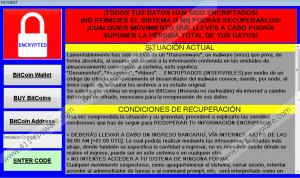Payment Ransomware Removal Guide
Payment Ransomware is a new file-encryptor that appears to be targeted at all Windows users who speak Spanish. It is unknown if the threat will target specific regions once it is fully completed, but we have to assume that users in all 20 countries that use the language officially could bet hit. Since many ransomware threats (including Jcoder Ransomware and Crypt888 Ransomware) are known for employing spam email attachments to slip into operating systems unnoticed, we have to warn you against interacting with email messages sent by unfamiliar senders. Note that cyber criminals could conceal themselves as postal agencies or airline carriers, and so you have to be careful about crooks posing as trustworthy parties as well. If you are not cautious, the ransomware slips in, and your files are doomed. Once in a blue moon, malware researchers are capable of creating functional decryptors, but, in most cases, the victims of ransomware threats end up losing their personal files. This is why you must keep your system protected against this threat, and, of course, you need to delete Payment Ransomware if it ends up invading.
The ransom note represented by Payment Ransomware, as we already mentioned, is in Spanish. The note informs about the encryption of files, and then it speaks about a ransom payment that, allegedly, is required if the victim wants to decrypt their files. The issue here is that you do not know whether or not your files were corrupted. That is because the ransomware locks the screen by displaying the ransom note in full-screen. Luckily, you can disable that by tapping keys “Alt” and “F4” at the same time. Since the infection is not set up to start up again after you restart the computer, you can also restart the PC to disable the screen-locker. Of course, take into account that once you close the ransom note, it is gone. Our research team, of course, recommends getting rid of this annoying locker because the information that cyber criminals introduce you to is unreliable anyway. All that the creator of Payment Ransomware wants you to do is to pay a ransom to specific Bitcoin Address. The address is not included in the current version of the ransomware. We also do not know how big the requested ransom is.
When any kind of malicious infection slithers in, you need to think about one thing: The security of your operating system. Sure, you might want to focus on the corrupted files and getting the control of your system back into your arms, but it is exceptionally important that you reassess your virtual security. Clearly, not everything is right because if your system was protected, you would not be dealing with malware right now. The right anti-malware software can help you greatly by protecting you and your system against dangerous threats and potentially undesirable programs. It is possible that such software already exists on your PC, but it might be outdated. Maybe it is not reliable at all? As you might know already, there are plenty of rogues that only pose as security assistants/malware removers, and, in reality, they are set up by cyber criminals who want to trick you into paying money for useless services. We suggest you install up-to-date and reliable anti-malware software right away, and not only because it can protect you hereafter but also because it can automatically remove Payment Ransomware.
Should you choose to install anti-malware software, you do not need to worry about the removal of Payment Ransomware or other existing threats. If you do not care to invest in your virtual security, you, at least, need to eliminate the ransomware. Keep in mind that at the time of research this malware was not completed, and it is possible that the manual removal guide you see below will not work in the future (if anything changes, the guide should be updated quickly). Hopefully, you will be able to delete the ransomware using it. In any case, and whatever question you might have regarding the Payment Ransomware removal process, we are here to assist you. The comments section is open to anyone who wants to discuss things further, and we suggest you use this opportunity without any hesitation.
How to delete Payment Ransomware
- Simultaneously tap Alt+F4 and close the screen-locker.
- Delete any recently downloaded suspicious files.
- Scan your operating system to see if malicious leftovers still exist.
- If any leftovers are found, delete them immediately.
Payment Ransomware Screenshots:


